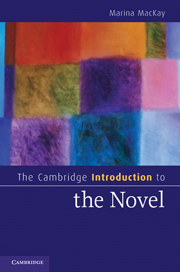Book contents
- Frontmatter
- Contents
- Acknowledgments
- About this book
- Chapter 1 Why the novel matters
- Miguel de Cervantes, Don Quixote (1605, 1615)
- Chapter 2 Origins of the novel
- Laurence Sterne, The Life and Opinions of Tristram Shandy, Gentleman (1759–67)
- Chapter 3 Narrating the novel
- James Hogg, The Private Memoirs and Confessions of a Justified Sinner (1824)
- Chapter 4 Character and the novel
- Nathaniel Hawthorne, The Scarlet Letter (1850)
- Chapter 5 Plotting the novel
- Gustave Flaubert, Madame Bovary (1857)
- Chapter 6 Setting the novel
- Charles Dickens, Bleak House (1853)
- Chapter 7 Time and history
- Virginia Woolf, To the Lighthouse (1927)
- Chapter 8 Genre and subgenre
- Graham Greene, The Ministry of Fear (1943)
- Chapter 9 Novel and anti-novel
- Thomas Pynchon, The Crying of Lot 49 (1966)
- Chapter 10 Novel, nation, community
- Salman Rushdie, Midnight's Children (1981)
- Chapter 11 Concluding
- Notes
- Glossary
- Further reading
- Index
- Cambridge Cultural Social Studies
Laurence Sterne, The Life and Opinions of Tristram Shandy, Gentleman (1759–67)
Published online by Cambridge University Press: 05 June 2012
- Frontmatter
- Contents
- Acknowledgments
- About this book
- Chapter 1 Why the novel matters
- Miguel de Cervantes, Don Quixote (1605, 1615)
- Chapter 2 Origins of the novel
- Laurence Sterne, The Life and Opinions of Tristram Shandy, Gentleman (1759–67)
- Chapter 3 Narrating the novel
- James Hogg, The Private Memoirs and Confessions of a Justified Sinner (1824)
- Chapter 4 Character and the novel
- Nathaniel Hawthorne, The Scarlet Letter (1850)
- Chapter 5 Plotting the novel
- Gustave Flaubert, Madame Bovary (1857)
- Chapter 6 Setting the novel
- Charles Dickens, Bleak House (1853)
- Chapter 7 Time and history
- Virginia Woolf, To the Lighthouse (1927)
- Chapter 8 Genre and subgenre
- Graham Greene, The Ministry of Fear (1943)
- Chapter 9 Novel and anti-novel
- Thomas Pynchon, The Crying of Lot 49 (1966)
- Chapter 10 Novel, nation, community
- Salman Rushdie, Midnight's Children (1981)
- Chapter 11 Concluding
- Notes
- Glossary
- Further reading
- Index
- Cambridge Cultural Social Studies
Summary
If you really want to hear about it, the first thing you'll probably want to know is where I was born, and what my lousy childhood was like, and how my parents were occupied and all before they had me, and all that David Copperfield kind of crap, but I don't feel like going into it, if you want to know the truth.
J. D. Salinger, The Catcher in the Rye (1951)Tristram Shandy is the most typical novel in world literature.
Viktor Shklovsky, Theory of Prose (1925)Tristram Shandy is a novel about what we expect novels to be. Through Tristram's unorthodox storytelling, plot dissolves into digressions (“take them out of this book … you might as well take the book along with them”); linear storytelling proves impossible; and the individuality of characters turns out to be a matter of bizarre private fixations, hobbyhorses. Tristram Shandy is the story of Tristram Shandy as Robinson Crusoe is the story of Robinson Crusoe, but even the seemingly simple structuring of the novel as a fictional autobiography turns out to be vastly more complicated than it sounds when Tristram tells the reader in his fourteenth chapter that he has been writing for six weeks and hasn't managed to get himself born yet. On the face of it, Tristram Shandy is so eccentric a work that it may be reckless to try and make it stand for anything other than itself; still, thinking about Tristram Shandy in relation to the rise of the novel can be illuminating for the very reason that our expectations are so brazenly thwarted at every stage.
- Type
- Chapter
- Information
- The Cambridge Introduction to the Novel , pp. 34 - 38Publisher: Cambridge University PressPrint publication year: 2010



